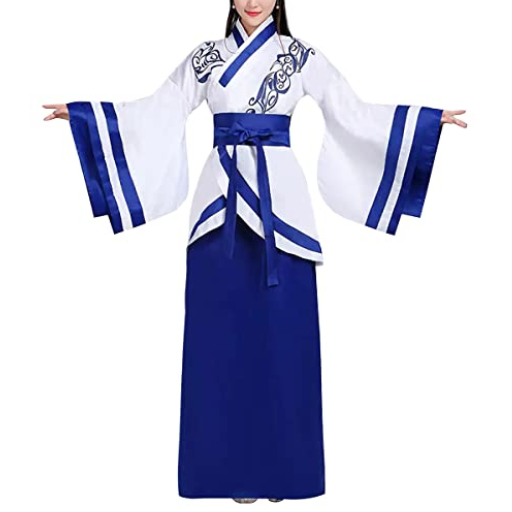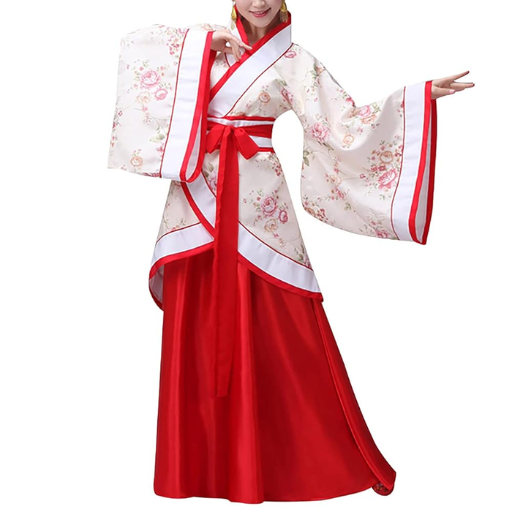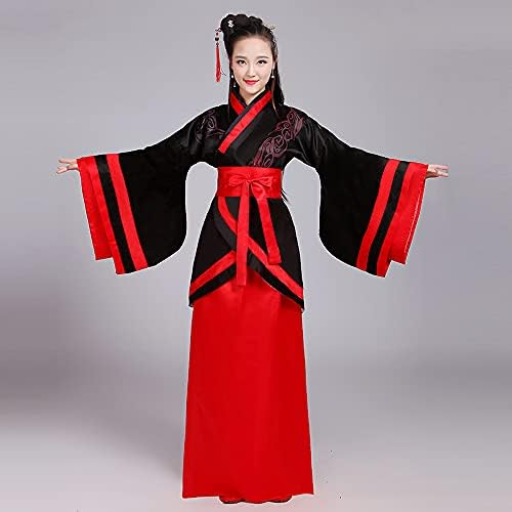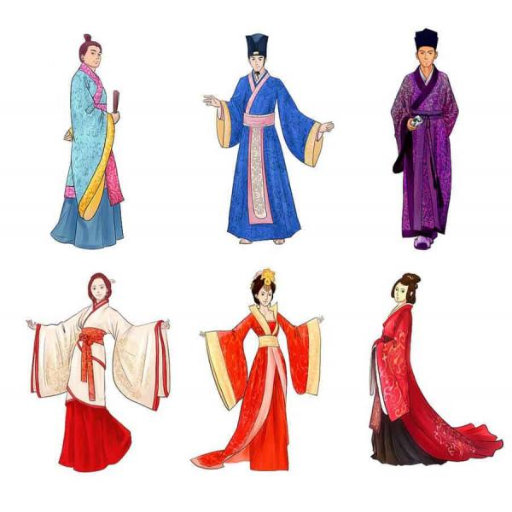Discovering the timeless elegance and cultural significance of Han Chinese traditional attire
Introduction to Hanfu

Hanfu is the traditional clothing of the Han Chinese people, an ancestral attire that dates back over four thousand years. The flowing lines and delicate design of Hanfu conjure images of fluidity and grace. Usually, an ensemble consists of either a robe or a tunic with crossed collars, wide sleeves, and a belt at the waist.
This particular fashion was not merely intended to satisfy aesthetic desires but was meant to symbolize cultural identity. Through the evolution of different dynasties, Hanfu underwent many changes in style and decoration, yet it remains a representative of classic Chinese culture and philosophy—a cultural time capsule recording history while serving as a platform for expressing both historical pride and modern-day cultural connection.
Definition and Origins
Hanfu, literally translating to “Han clothing,” refers to the traditional dress worn by the Han Chinese. Originating in the Yellow River basin—the cradle of Han civilization—Hanfu has a history spanning more than 4,000 years. The design is anchored in philosophical concepts of Confucianism, emphasizing harmony, simplicity, and elegance.
Recent reports from 2023 indicate that the Chinese Hanfu market has seen tremendous growth, driven by social media, cultural festivals, and public interest in reconnecting with traditional heritage. Modern adaptations have emerged to make Hanfu more accessible while preserving its traditional appeal.
Historical Significance in Ancient China
Hanfu traces its origins back 4,000 years to the earliest period of Chinese civilization, becoming a cultural symbol deeply linked with Han ethnic identity. Historical records indicate it originated during the Shang dynasty (circa 1600-1046 BCE), evolving through subsequent dynasties including Zhou, Han, Tang, and Ming.
The Han Dynasty Recognition
Between 206 BCE and 220 CE, the Han Dynasty officially recognized Hanfu as a paramount indicator of Han culture, establishing rules for proper attire based on rank and occasion. This bestowed upon clothing a significant place in the cultural, moral, and political order.
Archaeological findings, including preserved silks from the Ming Dynasty (1368-1644 CE), demonstrate sophisticated embroidery designs and ancient textile craftsmanship. These discoveries reveal that Hanfu patterns often incorporated auspicious symbols such as dragons, phoenixes, and clouds.
Evolution Through Different Dynasties

| Dynasty | Period | Key Characteristics | Cultural Influence |
|---|---|---|---|
| Han Dynasty | 206 BCE–220 CE | Wide sleeves, cross-collar robes, two-piece design | Confucian ideals of simplicity and modesty |
| Tang Dynasty | 618–907 CE | Bright colors, silk materials, elaborate embroidery | Cultural prosperity and Silk Road influence |
| Song Dynasty | 960–1279 CE | Tighter-fitting, understated patterns, refined aesthetics | Neo-Confucianism and scholarly culture |
| Ming Dynasty | 1368–1644 CE | Classical revival, wide robes, intricate embroidery | Traditional Chinese cultural renaissance |
Current studies indicate that modern Hanfu enthusiasts often select elements from multiple dynasties to create contemporary interpretations that honor historical designs while appealing to modern aesthetics.
Components of Hanfu
The traditional Hanfu consists of several key elements that work together to create an elegant ensemble:
Basic Garments and Their Functions
| Component | Chinese Name | Function | Symbolism |
|---|---|---|---|
| Upper Garment | Yi (衣) | Cross-collar top worn by both men and women | Harmony of yin and yang |
| Lower Garment | Shang (裳) | Skirts or trousers, often pleated for movement | Balance and natural harmony |
| Full Robe | Pao (袍) | Complete body covering for formal occasions | Status and ceremony |
| Half-sleeve Jacket | Banbi (半臂) | Layering piece for style and comfort | Versatility and practicality |
| Belt/Sash | Various terms | Securing garments and decoration | Unity and completion |
Layers and Their Importance
The layering system in Hanfu serves multiple purposes:
- Practical Function: Climate adaptation and comfort
- Social Significance: Indication of status and propriety
- Cultural Symbolism: Representation of traditional values
- Aesthetic Appeal: Creating flowing, graceful silhouettes
Cultural Significance of Hanfu

Symbolism in Colors and Patterns
Colors and patterns in Hanfu carry deep symbolic meanings rooted in Chinese philosophy and social structure:
Pattern Symbolism
- Dragons: Imperial authority and divine mandate
- Phoenix: Empress symbol, representing beauty and grace
- Lotus: Purity and elegance
- Peonies: Wealth and honor
- Clouds: Cosmic eternity
- Geometric patterns: Auspicious meanings and good fortune
Dress Codes and Social Status
Throughout Chinese history, dress codes served as crucial status markers. Imperial China implemented strict regulations where colors, fabrics, and ornamentations corresponded to social hierarchies. Imperial family members wore dragon-decorated robes symbolizing power, while commoners were restricted to simpler, undecorated fashions.
Hanfu in Modern Chinese Culture
The resurgence of Hanfu represents a significant chapter in modern Chinese culture, with younger generations embracing their cultural heritage through traditional attire. This revival extends beyond fashion to encompass cultural pride and identity expression.
Market Growth and Statistics
Digital and Social Media Impact
The internet has been instrumental in the Hanfu revival:
- Content Platforms: Bilibili and Xiaohongshu feature tutorials and cultural education
- Hashtag Movements: #Hanfu and #汉服热 are generating millions of views globally
- Online Communities: Forums connecting enthusiasts worldwide
- Cultural Events: Virtual and physical gatherings promoting traditional styles
Contemporary Trends in Hanfu Fashion

Fusion of Traditional and Modern Styles
Modern Hanfu designers are creating innovative interpretations that blend traditional elements with contemporary fashion:
- Short hemlines adapted for daily wear
- Slim silhouettes for modern body preferences
- Versatile fabrics suitable for various occasions
- Traditional prints on modern cuts
- Hanfu-inspired tops paired with jeans or modern skirts
Sustainable and Inclusive Design
The modern Hanfu movement embraces:
- Sustainable Materials: Organic silk, linen blends, eco-friendly dyes
- Inclusive Sizing: Designs for diverse body types
- Cultural Accessibility: Education for international audiences
- Artisan Support: Preserving traditional craftsmanship techniques
Preservation of Traditional Practices

The preservation of Hanfu traditions involves multiple approaches:
Educational Initiatives
- Workshops teaching traditional sewing techniques
- Cultural festivals celebrating Hanfu heritage
- Museum exhibitions showcasing historical garments
- Academic research preserving historical knowledge
Digital Preservation
- Online archives of historical designs
- Video tutorials for traditional crafts
- Digital museums and virtual exhibitions
- Social media cultural education campaigns
Frequently Asked Questions (FAQs)
Hanfu embodies the highest ideals of Chinese culture, incorporating Confucian principles of harmony, simplicity, and elegance. The garment represents traditional Chinese values and serves as a connection to Han cultural identity and heritage.
Each dynasty brought unique innovations: the Han Dynasty emphasized simplicity, the Tang Dynasty featured rich colors and flowing designs, the Song Dynasty favored refined minimalism, and the Ming Dynasty revived classical forms with intricate embroidery.
Hanfu features loose-fitting silhouettes, wide sleeves, layered structure, cross-collar design, and flowing fabrics. The clothing system typically includes an upper garment, skirt or trousers, and sometimes an outer robe, designed for comfort and elegance.
The movement organizes workshops, cultural events, fashion shows, and educational programs. Enthusiasts use social media, festivals, and community gatherings to share knowledge about Hanfu’s heritage and encourage both Chinese and international appreciation.
Traditional Hanfu uses silk (most prestigious), cotton, and linen. Silk remains the preferred choice due to its luxury feel and historical significance. Fabric choice depends on the occasion, with lighter materials for daily wear and more elaborate fabrics for formal events.
Modern Hanfu can be worn for daily expression, cultural celebrations, festivals, or special occasions. Contemporary styling includes pairing traditional elements with modern accessories, creating fusion looks, or wearing complete traditional ensembles for cultural events.
Conclusion
Hanfu represents far more than traditional clothing—it embodies thousands of years of Chinese cultural heritage, philosophy, and artistic achievement. From its ancient origins in the Yellow River basin to its modern digital revival, Hanfu continues to serve as a bridge between past and present, connecting contemporary generations with their cultural roots.
The remarkable growth of the Hanfu movement, with millions of enthusiasts worldwide and a billion-dollar market, demonstrates the enduring appeal of traditional aesthetics in our modern world. As Hanfu continues to evolve through fusion designs and sustainable practices, it maintains its core mission: preserving and celebrating the rich cultural legacy of the Han Chinese people while inspiring new generations to embrace their heritage.
Reference Sources
- Revival of Hanfu: The Rise and Fade of a Cultural Movement
This paper offers an overview of the Hanfu revival, explaining its cultural significance and placing the movement in historical context.
- The Equal Cut: Translating the Culture of Modern Hanfu as Capital
This research investigates the history and culture of Hanfu in the Han Fashion System.
- Trying to See how Qipao and Hanfu Gowns Might Represent China
This research examined how Hanfu and Qipao represent Chinese history and the aesthetics of fashion.







